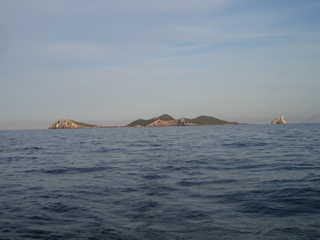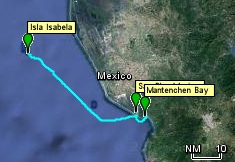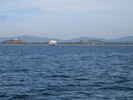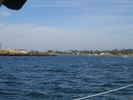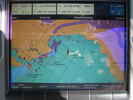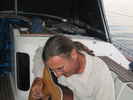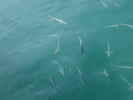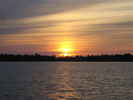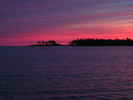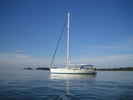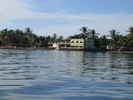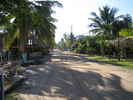To San Blas and Mantanchen BayAfter our lovely sojourn at Isla Isabela, it was time to get back to the mainland. And although I was concerned/scared about the anchor coming up, when we got up at 6:30 am, we had no trouble lifting the anchor and were on our way by 7:15. So we said goodbye to Isla Isabela and set a course for San Blas, Mexico (not to be confused with the San Blas Islands east of Panama). Several other boats were also making their way at about the same time, and so we were all in kind of a line heading for the coast, separated by a few miles from one another. At about 8:00 there was a flurry of activity on the VHF as someone triggered their DSC distress signal, which we'd never heard before, but which caused a loud siren to be emitted from our VHF radio. We were never able to confirm who sent the distress signal, but it may very well of been a panga fisherman, as one of the boats said that they had snagged a long line and the fisherman had frantically tried to radio them. The long line apparently wrapped around their propeller shaft and then was cut by their line-cutter, but some of the rope was still stuck because they were reporting a vibration. We took that opportunity, on their suggestion, to move a few degrees off the course line so as to avoid the same panga ourselves. As usual, we've now kind of got a habit of putting a line in the water first thing in the morning when getting underway, as the morning seems to be the best time to catch fish. Sure enough, at about 9:00 am, the line played out with it's characteristic whizzing noise! It turned out to be another Skipjack, probably about 5 lbs. Since we've now eaten 3 Skipjack in a little over a month (about 9 meals), we declined to keep him, and threw him back, hoping for a little variety, but we did not hook anything throughout the rest of the leg. There wasn't much wind thru the morning, and even in the afternoon a good breeze failed to materialize, so we ended up motoring all the way to San Blas, about 40 nm, in about 7 hours. The water was glassy and the day was very warm and humid. I was already getting concerned about the potential for bugs in San Blas if this was any indication of how things were going to be. Nonetheless, we continued for San Blas until the distinctive white rock of Piedra Blanca came up on our port beam. Once again there was a huge discrepancy between the chart and the reality (over 1 nm difference). In fact, in the photo of the chartplotter, in the group below, it is hard to tell where the entrance to the channel really is compared to the purple of the radar. Fortunately it was a clear day so we had no problem figuring it out visually. As we were approaching the entrance channel a shrimp boat started coming up behind us, so I did a quick circle hoping to follow him into the channel, but he veered off and did not go in, so after a little discussion, we decided to try the channel ourselves. Of course, we made all of the mistakes. First, by the time we got to the channel it was very nearly absolute low tide. Second, in spite of the recommendations in the cruiser's guide to contact "Norm" on channel 22 for bar crossing information, we just decided to try it ourselves, without any outside help. Thirdly, we later learned that we should have lined up the range markers, but we didn't realize they were there as we turned the corner into the channel. So, as we were entering the channel, I was at the helm watching the depth sounder. At first we were in green water, indicating some depth to play with. Off to my right I could clearly see the brown muddy water indicating a shoal, and off to my left, only a few yards away were the rocks of the break water. As I tried to work between the two hazards, I was calling out the depth on the sounder and watching the water in front of the boat change to brown. Twelve .... twelve .... ten ... Eight .... SIX ... FOUR .... and as I said TWO the sounder display went to zero and the boat ground to a halt !! Yikes! The sensor for the depth sounder is on the bottom of the hull just forward of the keel, about 2 feet under water. The keel goes down another 4 feet, giving us an overall draft of 6 feet. So apparently I was in about 2 feet of water at that point. Fortunately I was only going about 2 knots, and it felt like we hit soft sand and mud rather than rocks, but the bottom went out of my stomach when I felt the boat stop. This was the first time I had grounded Rhapsody, bringing to mind the old saying "There are two kinds of sailors; those who HAVE gone aground and those who WILL go aground". In a heartbeat, I crammed the transmission in reverse and gave it a healthy dose of power, and in a few seconds we were backing out the way we had come in. I kept the boat in reverse for almost a mile lol, until we were back out around Punta Camarones. I'm sure the guys on the shrimp boat were watching (and probably chuckling). It must have looked pretty strange to see a sailboat going backwards that fast for that distance. But we were just happy, at that point, to be moving and in deeper water. When we got back out to 25+ feet of water, I turned the boat around and put it in forward again and idled around while we discussed our options. We told ourselves that we didn't really want to be in San Blas harbor, because of the proximity of land and all of the bugs we were likely to get there, and agreed among ourselves that Mantanchen Bay, right around the corner, and which we would likely have visited anyway, would be a better destination. So, we motored around to Mantanchen Bay where there were about 4 boats already at anchor in the very large bay. We had no problem finding a good location to anchor between A CAPPELLA and another boat nearer shore in about 10-12 feet of water (at the still low tide). As I was sitting there that night strumming the guitar, Ed and Cornelia from A CAPPELLA came by and we chatted with them for a bit as they made their way back to their boat. Then, one of the locals who was out fishing with his sons came up to Rhapsody indicating that he also played the guitar. We invited them all aboard, tied their boat off, and when they climbed on, gave the three boys Pepsi's and the father shared a beer with us and sang some beautiful Mexican songs and played the guitar for us. Soon the sun had set and they had to leave, we had dinner, and called it a day. We spent four nights in Mantanchen Bay. The first night, after the grounding, we got a little drunk (in relief at not grounding), so we spent much of the second day just recuperating, reading, writing journal entries and evaluating the bug situation. We found that there were nearly no biting bugs during the day and small precautions kept them out of the boat, so we did not suffer many bites during our stay. Also of interest to us were the fish. All day long there were schools of these small fish around us. When the folks from WIREWALKER, a catamaran from San Fransisco, came by on a kayak, I asked them if they knew what kind of fish they were. They called them "poo fish", joking that they lived on the human waste output by cruisers. Of course, this was not true, as they fed on mosquitos and no-seeums, especially in the morning and early evening, but I call them Poo Fish anyways :-) On the third day, we did the dinghy drill, thinking to land in Mantanchen Village and then walk or take a cab over to San Blas, but when we got to the village, it was pretty sleepy (at 9:00 a.m. and apparently off season). One restaurant said they would open at 4:00 pm that afternoon. So we decided that, instead of taking a cab, we would take the dinghy out around the point and to San Blas for some sight-seeing. |
